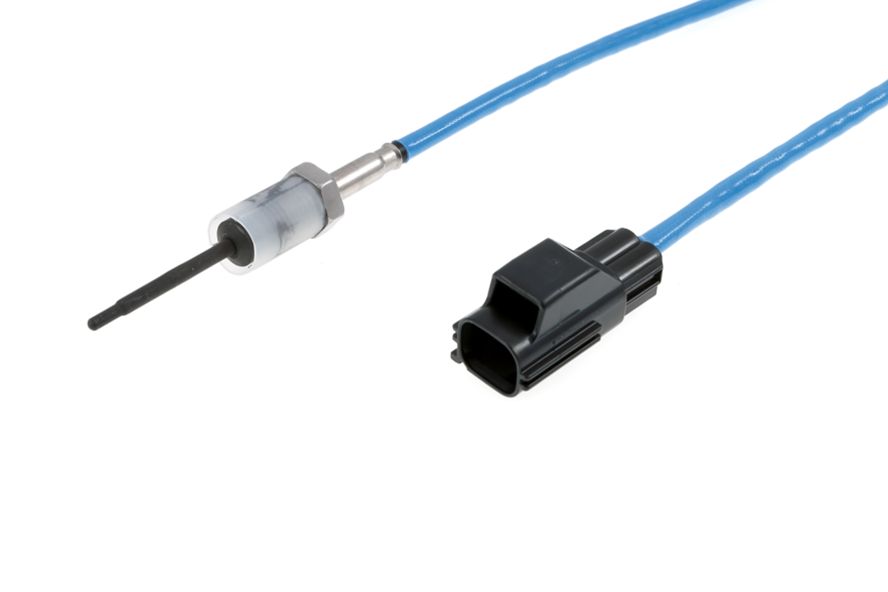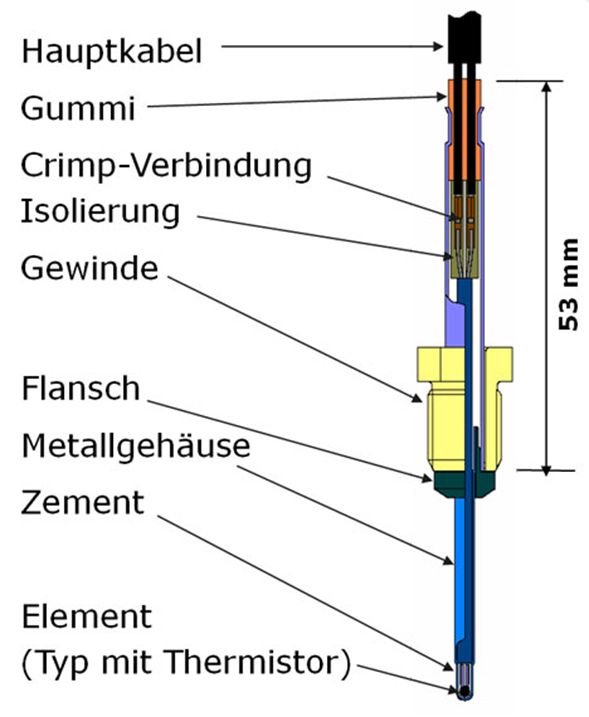Exhaust gas temperature sensor
Exhaust gas temperature sensors are an indispensable feature of modern vehicles, as they guard components exposed to the flow of hot exhaust gas against critical overheating.
Function
Engines are becoming increasingly environment-friendly and economical but at the same time ever more powerful. This is primarily achieved by way of so-called downsizing, which involves designing engines with a smaller capacity and employing turbocharging or supercharging to compensate for the associated loss of power.
 As a consequence of this development, exhaust gas temperature sensor technology has become ever more complex in recent decades. Whereas the main purpose of the sensors was originally to monitor catalytic converters, they have since become absolutely essential to protect components.
The sensor element is fitted at the tip of the housing. The element takes the form of an NTC (negative temperature coefficient) thermistor. This means that it has a high resistance at low temperature and a low resistance at high temperature. In other words, the resistance decreases with increasing temperature. A temperature is assigned to each measured resistance in the control unit.
As a consequence of this development, exhaust gas temperature sensor technology has become ever more complex in recent decades. Whereas the main purpose of the sensors was originally to monitor catalytic converters, they have since become absolutely essential to protect components.
The sensor element is fitted at the tip of the housing. The element takes the form of an NTC (negative temperature coefficient) thermistor. This means that it has a high resistance at low temperature and a low resistance at high temperature. In other words, the resistance decreases with increasing temperature. A temperature is assigned to each measured resistance in the control unit.
 The possible measuring range and the exact resistances assigned to the temperatures vary depending on the design of the sensor. The element material is based on a perovskite structure formed by titanium trioxide (TiO3) alloys.
The possible measuring range and the exact resistances assigned to the temperatures vary depending on the design of the sensor. The element material is based on a perovskite structure formed by titanium trioxide (TiO3) alloys.
Exhaust gas temperature sensors in petrol and diesel engines
These days, exhaust gas temperature sensors are used in cars with both diesel and petrol engines. Petrol engines In petrol engines, the main function of exhaust gas temperature sensors is to protect components against overheating. The critical components to be monitored in this case are primarily the turbocharger and the catalytic converter. If the temperature sensor signals excessive temperatures at these components, the engine control unit takes appropriate action to lower the temperature, for instance by reducing the boost pressure (and thus the power). Depending on the setting of the engine management system, catalytic converter protection is provided by increasing the injected fuel quantity (and thus fuel consumption) to cool the catalytic converter. Advanced modern engines with direct injection and sometimes lean burn operation are particularly critical in this respect and require appropriate monitoring. Diesel engines In diesel engines, exhaust gas temperature sensors are also used to monitor the temperature of the diesel particulate filter (DPF). The emphasis is not so much on protection against overheating in this case. It is more a question of establishing that the temperature required for self-cleaning (regeneration) of the particulate filter is achieved. Further applications of exhaust gas temperature sensors Exhaust gas temperature sensors are also used in nitrogen oxide (NOX) reduction assemblies. These include NOX storage catalysts for petrol and SCR or LNT catalytic converters for diesel engines. Here, the purpose of temperature monitoring is to check attainment of the minimum temperature needed for operation of the catalytic converters and to guard these against overheating. The latest generations of exhaust gas temperature sensor have a measuring range from -40 to +900˚C Certain exhaust gas recirculation systems are now also equipped with temperature sensors. The measured value is used for EGR system diagnosis (OBD). These sensors basically function in the same way as the other exhaust gas temperature sensors, they are however more compact and have a lower maximum measurable temperature of 400˚C.
Installation positions
The installation positions of the temperature sensors vary according to the purposes for which they are used as described above: They are fitted upstream or downstream of the turbocharger, upstream or downstream of the catalytic converter, upstream and downstream of the DPF (diesel particulate filter) and at the components of the NOX reduction system.Installation positions of exhaust gas temperature sensors
The installation positions of the temperature sensors vary according to the purposes for which they are used as described above: They are fitted upstream or downstream of the turbocharger, upstream or downstream of the catalytic converter, upstream and downstream of the DPF (diesel particulate filter) and at the components of the NOX reduction system.











